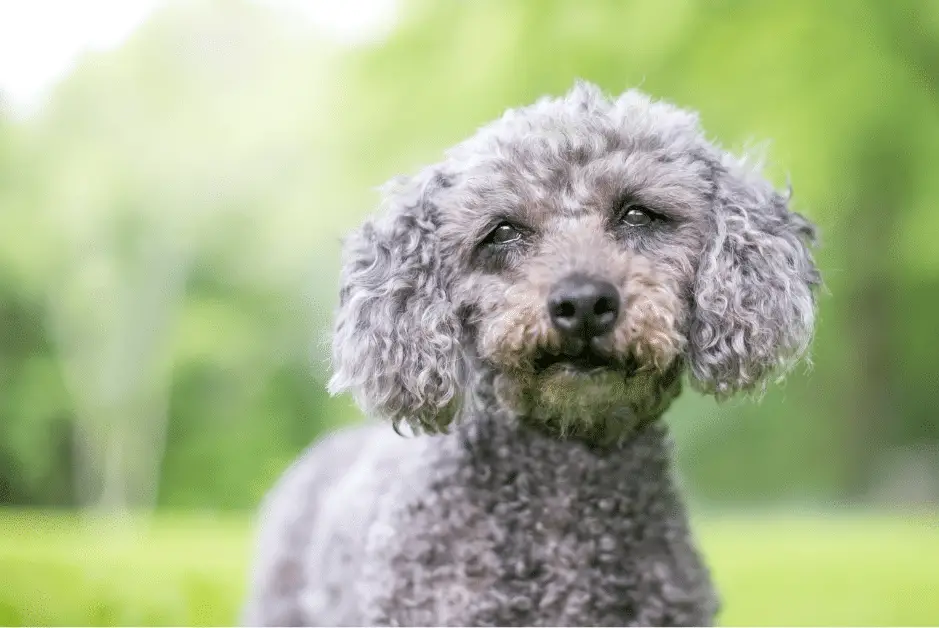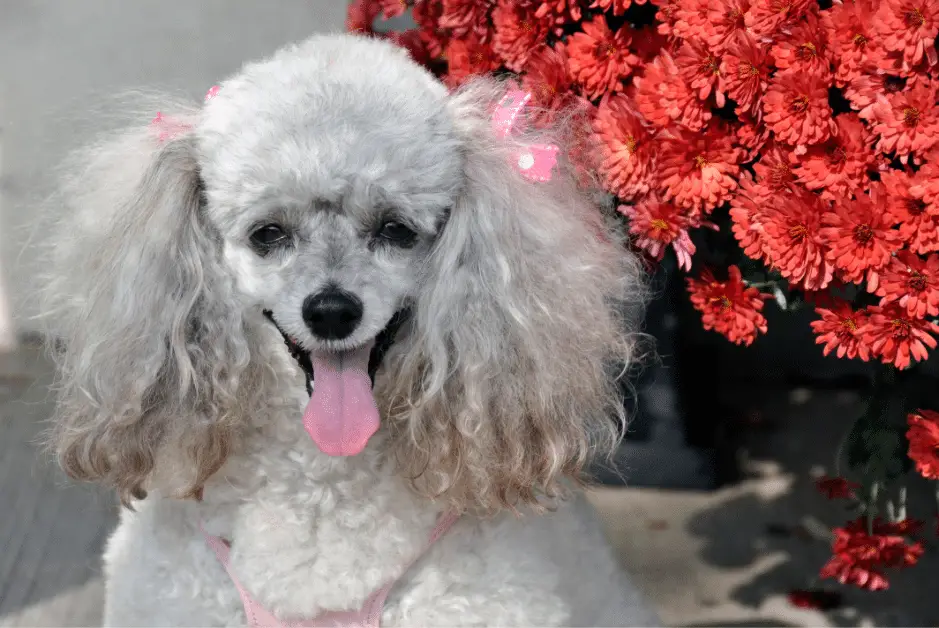Are you thinking of welcoming a gray poodle into your home? These elegant and intelligent dogs are not just a stunning addition to any family but also come with unique characteristics and care requirements. From their distinctive coats to their lively personalities, gray poodles offer a blend of beauty and brains that is hard to resist.

Well, we’ll be going over:
- What makes the gray poodle’s coat so unique and how to maintain it?
- What are the personality traits and behaviors you can expect from a gray poodle?
- How to ensure the health and happiness of your gray poodle through proper care and training?
Let’s dive in and discover the charming world of gray poodles!

Read our Smart Poodles - Smart Tricks eBook for only $2.99
Dive into a treasure trove of engaging tricks and tips designed specifically for your poodle!
Gray Poodles, recognized since 1966, range from light ash blue to dark silvery gray. They possess thin, soft coats and sensitive skin, and are known for their intelligence and easy trainability, displaying strong imitation of owner behavior.
What Will You Learn? 👇
The origin story
Poodles are ancient dogs with a hazy but exciting past. Several breeds of dogs are considered their ancestors at once, from which they inherited qualities useful for life. The progenitors – a curly-haired German shepherd and a water barbet – helped poodles become assistants to workers and then quickly enter the homes of the nobility to remain there in abundance and satiety until the war.
Archaeologists discovered the first mentions of a breed similar to poodles in Sicily – there were coins of the thirteenth century with similar dogs’ images. Besides, Reims Cathedral is decorated with pictures of frolicking poodles.
The distribution of the breed from French-speaking countries (France, Belgium) and Germany around the world dates back to the middle of the fifteenth century. At first, curly-haired dogs charmed the villagers (they were excellent helpers, especially for shepherds and hunters), and then, closer to the middle of the 16th century, they fascinated the nobility. From this point on, poodles were considered decorative dogs rather than working dogs.
The first breed standard was published in the UK, then in Germany. The standards were strikingly different: the British were more graceful than the Germans. However, the breed is considered French for a reason: in 1936, the International Kennel Federation approved the French breeder Galliani standard.

What does a Gray poodle look like?
Gray is one of the oldest colors inherent in the shepherd’s ancestors of poodles. Despite its antiquity, the International Kennel Federation has not recognized the gray color for a long time. However, it was trendy in the USA, Great Britain, and Germany.
It was only since 1966 that gray color was included in the FCI standard. Since then, it has been allowed to give excellent marks to gray poodles at shows in the FCI system and award CAC and CACIB certificates (i.e., a certificate of contender for the title of national or international champion). It should be noted that together with the apricot and red colors, the gray color is included in the group of “modern” colors of poodles.
The gray poodle can be also similar to the cafe au lait poodle, so make sure to read the article and have a better understanding of it.
The term “gray” unites a whole range of colors: from light ash blue to the color of old dark silver or even the asphalt. The lightest and darkest options are the least desirable. The most preferred of them is a silvery-gray color with a cold blue sheen, without the slightest shade of brown or yellowish, and as evenly distributed as possible throughout the body.
The most common defects are a faded coat at the bottom of the paws and a brown tint at the hair’s tips, creating a brownish coating. The coat of gray poodles is thinner and softer than that of other colors. Their skin is sensitive, easily irritated, and the short-haired gray poodle can quickly develop sunburn in summer. An utterly black coat grows at the site of scratches, bites, and other skin lesions. The skin of a gray poodle should be lilac or purple. The nose, eyelids, and lips, as well as nails, are only black. The eyes should be as dark as possible, but brown and hazel colors are also acceptable.
Gray poodle puppies are born adorable!
Gray poodle puppies are born black, and at the age when they are considered and chosen by future owners, they are just beginning to brighten.
The coat begins to fade on the very skin of the muzzle and paws. The black color gradually fades towards the ends of the coat, giving way to gray. When three-week-old gray poodle puppies have their muzzles and paws trimmed, they look charming. By 6-8 months, the coat should turn gray all over the body, but it will look almost black on unshorn places – the ends of the coat will not fade. Fading ends by about 1.5 – 2 years.
It happens that the puppy starts to fade but never turns gray. At best, by the age of three, such a poodle will be similar in color to a dark Kerry Blue Terrier. This happens when breeding poodles of different colors when only one parent is gray. Mixing pairs is only possible when breeding white poodles (gray x white). No other combinations with gray are allowed.
Rarely, but still, it happens that a puppy is born immediately gray. Breeders and owners should handle these “gray” poodles with care as they can have severe hereditary anomalies.
So, remember that a gray poodle puppy at eight weeks old should have black hair on its body, gray muzzle, and paws. The nose, eyelids, and lips, as well as the nails, should be completely black. The puppy’s eyes should be dark; the darker, the better. However, if your puppy has green or blue eyes, they will turn transparent yellow with age.
Varieties of gray poodles
- Gray Standard Poodles (Royal): These are the largest of the breed. The withers’ height can reach 45-60 cm, and the weight ranges from 20-32 kg. This variety is safe for people with animal allergies.
- Gray Medium Poodle (French): Externally resembles a royal poodle. The medium gray poodle differs from its congeners in smaller stature and greater mobility. The French poodle can be 35-45 cm at the withers; these poodles’ weight is 6-8 kg.
- Gray Miniature Poodles: This variety is also called the “Scottish Poodle.” The height of these poodles ranges from 28-35 cm.
- Gray Toy Poodle: This variety is also called the “Japanese Miniature Poodle.” It differs from the standard miniature breed in more miniature parameters. Its maximum height is no more than 27 cm.
Training gray poodles

Gray poodles are very obedient and easy to train. They also have a strong sense of shame and imitation of their owners’ behavior. There is simply nothing to punish them for. It is enough to explain or show the poodle once or twice what to do and how to do it, and he will remember the lesson for life.
If the explanation turns out to be not too tedious and informative but very convincing, and you shame your poodle at the right time and in the right place, then you will soon become the owner of a perfectly educated dog.
The owner of the famous American kennel “Graphics” Florence Graham says that gray poodles resemble children dressed in hair coats. So, you need to treat them like children, that is, communicate a lot, talk, explain all the time what you do and what your poodle should do, and, of course, play a lot with him.
The poodle does not need a lot of training. As long as your gray poodle is a little puppy, you must “transform into a dog” and become his partner in games. However, the childhood of a poodle passes quickly, your adorable child grows up, and his humanization takes place literally before your eyes.
And now he already begins to consider himself a person and shares your hobbies and affairs. It thinks that human life is such a game, and he tries to imitate people, for example, he collects his toys and puts them in a box or brings the necessary things, especially if you have previously played a game with your poodle during which you explain to him how these things are called and where they lie.
Frequently Asked Questions
When buying a poodle puppy, can you be sure it turns pure gray?
A poodle puppy will turn pure gray if:
the color around the muzzle and eyes is a pure, actual shade of gray,
the gray color is already clearly visible on the paws,
the roots of the body coat have faint signs of the same gray color,
the black color of the coat is not saturated, real black, but rather a grayish tint.
Can you get gray poodles by crossbreeding black and white poodles?
This is only possible if whites carry the modifying genes necessary for the formation of gray. Remember that the colors of living things are not paints mixed in a palette!
Marko is the founder and author at PoodleHQ, where he blends profound expertise with formal training in Animal Behavior and Canine Genetics. With multiple generations of poodles under his care, he’s a breed connoisseur, honored with the Canine Care Excellence Award and lauded by the International Pet Enthusiasts Association.

